

Scientia Silvae Sinicae ›› 2020, Vol. 56 ›› Issue (10): 145-153.doi: 10.11707/j.1001-7488.20201016
Previous Articles Next Articles
Youming Xu,Caixia Zhou,Han Lin,Jiyun Tao,Juhua Zhang
Received:2018-08-07
Online:2020-10-25
Published:2020-11-26
CLC Number:
Youming Xu,Caixia Zhou,Han Lin,Jiyun Tao,Juhua Zhang. Ultrastructural Changes of the Cambial Cells of Pinus elliottii during the Periods of Recovery Activity, Activity and Dormancy[J]. Scientia Silvae Sinicae, 2020, 56(10): 145-153.
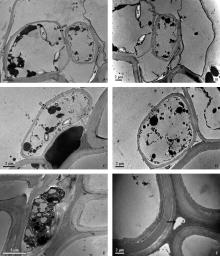
Fig.1
The ultrastructure of cambium cells during the reactivation period (March 22th) of P. elliottii A—D: The cross-section of the cambium cells; E—F: The cross-section of the secondary xylem cells. A. The cytoplasmic concentration of the fusiform cells was reduced, the boundary between the cambium zone and the xylem was obvious, and there was autolysis at the corners of the cell wall. B. The starch particles appeared electron transparent zone and the diameter began to decrease, and its the content also decreased. C. The protoplasts condense and showing the significant plasmolysis, the cytoplasm was a strip distribution adherent cell wall. D. The autolysis occurred at the corner where the radial wall was connected to the tangential wall (arrow), the diameter of the oil droplets decreased and inclusions were distributed unevenly. E. Xylem ray cells contained abundant contents and scattered small vacuoles. F. The tracheid formed in the previous year occurred autolysis in the intercellular layers. "

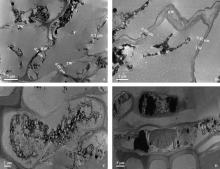
Fig.2
The ultrastructure of cambium cells during the active period (April 18th) of P. elliottii A.The entire cambial cells had been highly vacuolated, the radial wall and tangential wall were significantly thinned, and the shape of cambial cells was very irregular. B. The tangential wall of the cambium cell was thinner, and the thickness of the radial wall and the tangential wall was obviously different. C. The cambium cells near the xylem was abundant in contents. D. The ray cells formed in the previous year contained large oil droplets, the nucleus was located in the middle and the starch granules showed the electron transparent zone. "


Fig.3
The ultrastructure of cambium cells during the active period(May 11th) of P. elliottii A. The fusiform cells near the secondary thickened xylem cells, the arrow showed the pit aperture. B. The cell wall had abundant in plasmodesmata, with cytoplasm adhering to the wall and containing a small amount of inclusions. "
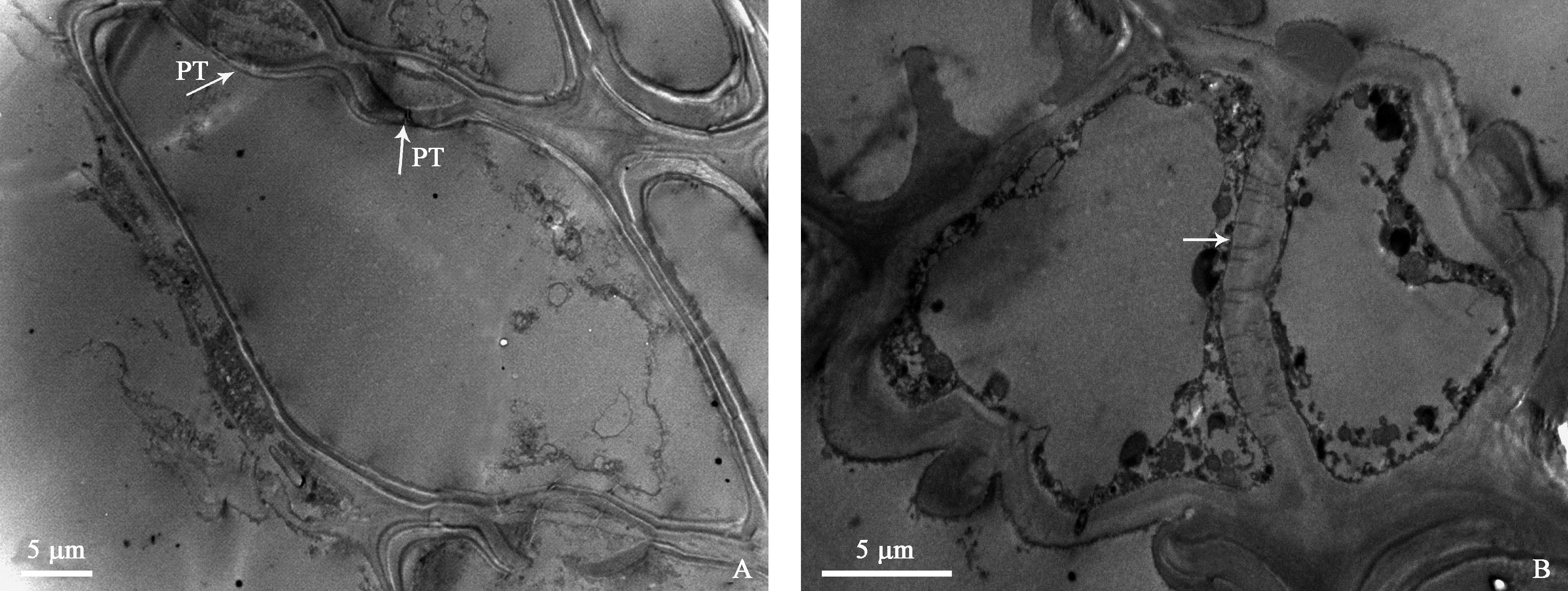
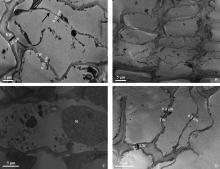
Fig.4
The ultrastructure of cambium cells during the active period(June 22th) of P. elliottii A. The fusiform cells were highly vacuolated, with significant differences between the radial wall and the tangential wall, and there were abundant granular materials near the primary wall. B. The cambium cells near the phloem cells, the tangential wall was thick, but the radial wall was still thicker than the tangential wall. C. The ray cells formed in the previous year contained a small amount of inclusions and the nucleus was irregular. D. The radial walls of cambium cells was obviously thickened. "


Fig.5
The ultrastructure of cambium cells during the active period(September 23th) of P. elliottii A. There were only 2-3 layers of cambium cells, and the radial wall and the tangential wall was significantly different. B. The xylem cells near the cambium cells had completed the secondary wall thickening and developed into mature cells with the distinct layered structure. The fusiform cells contained many granular substances. "
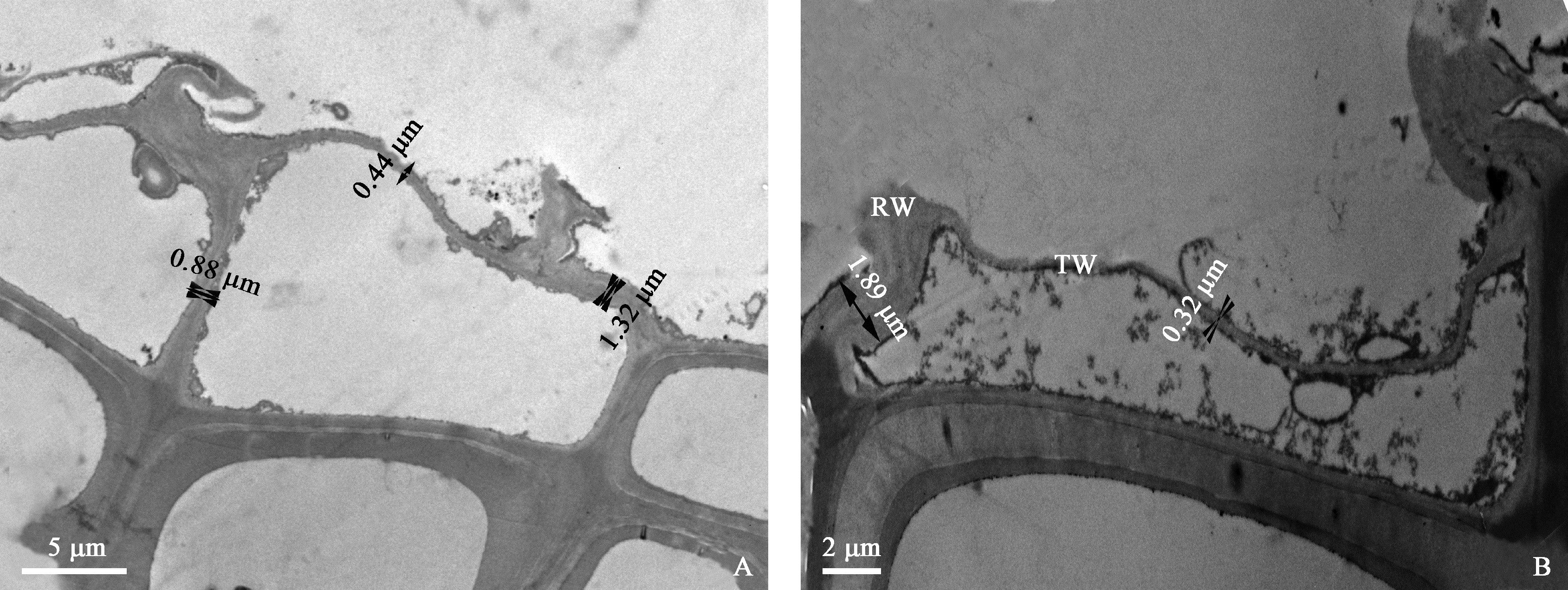

Fig.6
The ultrastructure of cambium cells during the dormant period (October 26th) of P. elliottii A. The xylem ray cells contained more inclusions, small vacuoles fused into large vacuoles, most of the vacuoles were filled with dark protein material. B. There are abundant plasmodesmata on the horizontal wall of ray cells. "
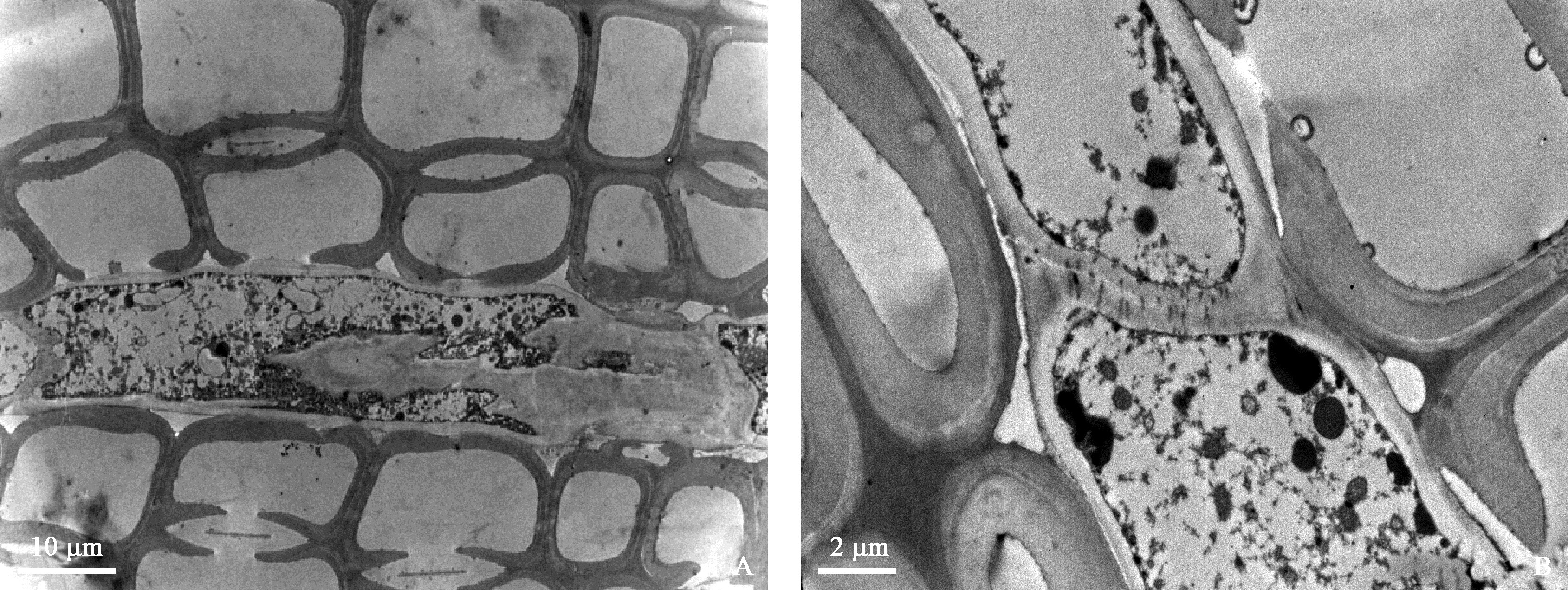

Fig.7
The ultrastructure of cambium cells during the dormant period (January 17th) of P. elliottii A. The cambium zone consisted of only 1-2 layers of thick-walled cells and contained many dark substances. The tangential walls and radial walls of the cambial cells were thicker, and the thickness of the radial walls was significantly thicker than the tangential wall. B. In the xylem ray cells, small vacuoles began to fuse into large vacuoles, and showing slight plasmolysis. "
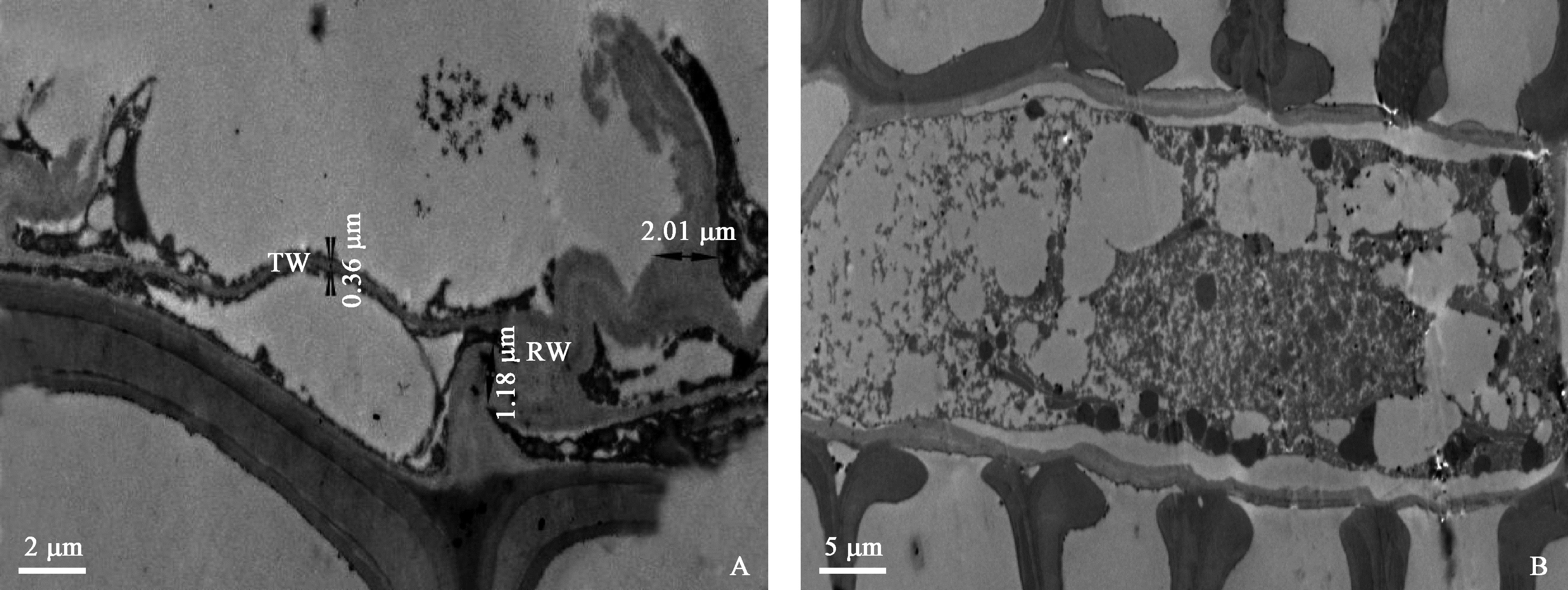
| 黄齐, 张聃, 曹昀, 等. 湿地松在沙化土地恢复中的对策. 江西科学, 2010. 28 (3): 333- 335, 385. | |
| Huang Q , Zhang D , Cao Y , et al. The problems and countermeasures of Pinus elliottii in sandy vegetation restoration. Jiangxi Science, 2010. 28 (3): 333- 335, 385. | |
| 肖兴翠, 张志兰, 李志辉, 等. 不同强度修枝对湿地松中龄林干形的影响. 中南林业科技大学学报, 2015. 35 (9): 22- 29. | |
| Xiao X C , Zhang Z L , Li Z H , et al. Effects of different intensities of pruning on stem form of middle-aged Pinus elliottii plantation. Journal of Central South University of Forestry and Technology, 2015. 35 (9): 22- 29. | |
| 徐有明, 林汉, 魏柏松, 等. 间伐强度对湿地松人工林木材质量的影响效应. 东北林业大学学报, 2002. 30 (2): 38- 42. | |
| Xu Y M , Lin H , Wei B S , et al. Effects of thinning intensities on wood properties of exotic slash pine plantation. Journal of Northeast Forestry University, 2002. 30 (2): 38- 42. | |
|
Antonova G F , Stasova V V . Seasonal development of phloem in scots pine stems. Russian Journal of Developmental Biology, 2006. 37 (5): 306- 320.
doi: 10.1134/S1062360406050043 |
|
|
Arend M , Fromm J . Ultrastructural changes in cambial cell derivatives during xylem differentiation in poplar. Plant Biology, 2003. 5 (3): 255- 264.
doi: 10.1055/s-2003-40796 |
|
| Begum S , Kudo K , Matsuoka Y , et al. Localized cooling of stems induces latewood formation and cambial dormancy during seasons of active cambium in conifers. Annals of Botany, 2015. 117, 465- 477. | |
|
Begum S , Nakaba S , Yamagishi Y , et al. A rapid decrease in temperature induces latewood formation after reactivation of cambium in conifer stems by localized heating. Annals of Botany, 2012. 110, 875- 885.
doi: 10.1093/aob/mcs149 |
|
| Carrer M , Castagneri D , Prendin A L , et al. Retrospective analysis of wood anatomical traits reveals a recent extension in tree cambial activity in two high-elevation conifers. Frontiers in Plant Science, 2017. 8, 1- 13. | |
|
Chen H M , Han J J , Cui K M , et al. Modification of cambial cell wall architecture during cambium periodicity in Populus tomentosa Carr. Trees, 2010. 24 (3): 533- 540.
doi: 10.1007/s00468-010-0424-y |
|
| Evert R F . Vascular cambium//Esau's plant anatomy:meristems, cells, and tissues of the plant body:their structure, function, and development. John Wiley & Sons, Inc, 2006. 323-355 | |
|
Fromm J , Rockel B S , Windeisen E , et al. Lignin distribution in wood cell walls determined by TEM and backscattered SEM techniques. Journal of Structural Biology, 2003. 143 (1): 77- 84.
doi: 10.1016/S1047-8477(03)00119-9 |
|
| Guo H H , Li F L , Gao S M . Ultrastructural study on development of needle resin ducts in Pinus elliottii Engel. Forestry Studies in China, 2002. 4 (2): 68- 72. | |
| Harley G L , Grissinomayer H D , Franklin J A , et al. Cambial activity of Pinus elliottii var. densa reveals influence of seasonal insolation on growth dynamics in the Florida Keys. Trees, 2012. 26 (5): 1449- 1459. | |
|
Hafrén J , Fujino T , Itoh T , et al. Ultrastructural changes in the compound middle lamella of Pinus thunbergii during lignification and lignin removal. Holzforschung, 2000. 54 (3): 234- 240.
doi: 10.1515/HF.2000.040 |
|
|
Huang J G , Deslauriers A , Rossi S . Xylem formation can be modeled statistically as a function of primary growth and cambium activity. New Phytologist, 2014. 203 (3): 831.
doi: 10.1111/nph.12859 |
|
| Jelonek T . The novel relationship between the morphplpgical characteristics of trees and ultrastructure of wood tissue in scots pine (Pinus sylvestris L. ). Wood Research, 2015. 60 (4): 519- 530. | |
| Kwon O . Investigation of bordered pit ultrastructure in tracheid of korean red pine (Pinus densiflora) by confocal reflection microscopy. Journal of the Korean Wood Science & Technology, 2014. 42 (3): 346- 355. | |
| Liu R R , Xu Y M , Zhang J Y , et al. Seasonal changes of cambium activity in Koelreuteria bipinnata Franch. in the subtropic zone of China. Phyton Annales Rei Botanicae, 2014. 54 (1): 149- 160. | |
|
Min D , Xu Y M , Han L , et al. Seasonal dynamics in cambial activity and the formation of xylem and phloem in the branches of Cinnamomum camphora. Dendrobiology, 2016. 75, 13- 21.
doi: 10.12657/denbio.075.002 |
|
|
Oladi R , Pourtahmasi K , Eckstein D , et al. Seasonal dynamics of wood formation in oriental beech (Fagus orientalis Lipsky) along an altitudinal gradient in the Hyrcanian forest, Iran. Trees, 2011. 25 (3): 425- 433.
doi: 10.1007/s00468-010-0517-7 |
|
|
Oliveira J M , Santarosa E , Pillar V D , et al. Seasonal cambium activity in the subtropical rain forest tree Araucaria angustifolia. Trees, 2009. 23 (1): 107- 115.
doi: 10.1007/s00468-008-0259-y |
|
|
Prislan P , Schmitt U , Koch G , et al. Seasonal ultrastructural changes in the cambial zone of beech (Fagus sylvatica) grown at two different altitudes. Iawa Journal, 2011. 32 (4): 443- 459.
doi: 10.1163/22941932-90000070 |
|
| Pumijumnong N , Wanyaphet T . Seasonal cambial activity and tree-ring formation of Pinus merkusii and Pinus kesiya in Northern Thailand in dependence on climate. Forest Ecology & Management, 2006. 226 (1/3): 279- 289. | |
|
Rao K S , Rajput K S . Relationship between seasonal cambial activity, development of xylem and phenology in Azadirachta indica growing in different forests of Gujarat State. Annals of Forest Science, 2001. 58 (6): 691- 698.
doi: 10.1051/forest:2001156 |
|
| Rao K S , Dave Y S . Ultrastructure of active and dormant cambial cells in teak (Tectona grandis L.f).. New Phytologist, 2010. 93 (3): 447- 456. | |
| Song K , Liu B , Jiang X , et al. Cellular changes of tracheids and ray parenchyma cells from cambium to heartwood in Cunninghamia lanceolata. Journal of Tropical Forest Science, 2011. 23 (4): 478- 487. | |
| Singh N D , Venugopal N . Cambial activity and annual rhythm of xylem production of Pinus kesiya, Royle ex. Gordon (Pinaceae) in relation to phenology and climatic factors growing in sub-tropical wet forest of North East India. Flora, 2011. 206 (3): 198- 204. | |
|
Singh A P , Daniel G . The S2 Layer in the tracheid walls of Picea abies wood:inhomogeneity in lignin distribution and cell wall microstructure. Holzforschung, 2001. 55 (4): 373- 378.
doi: 10.1515/HF.2001.062 |
|
| Sivakumar P , Ingwers M W , Victoriano O L , et al. Cell wall ultrastructure of stem wood, roots, and needles of a conifer varies in response to moisture availability. Frontiers in Plant Science, 2016. 7, 1- 11. | |
|
Wu H , Xu H , Li H , et al. Seasonal development of cambial activity in relation to xylem formation in Chinese fir. Journal of Plant Physiology, 2016. 195, 23- 30.
doi: 10.1016/j.jplph.2015.12.013 |
|
| Yin Y F , Jiang X M , Cui K M . Seasonal changes in the ultrastructure of the vascular cambium in shoots of Populus tomentosa. Acta Botanica Sinica, 2002. 44 (11): 1268- 1277. | |
| Zhong G H , Liang Z Y , Shen M Y , et al. Study on chemical constituents of oleoresin from Pinus elliottii in Guangxi. Chemistry & Industry of Forest Products, 2001. 21 (3): 29- 33. |
| [1] | Xiaochen Song,Xiyang Wang,Guang Yang,Guihua Huang,Zaizhi Zhou,Kunnan Liang,Qingqing Zhang. Mechanism of Agarwood Formation under the Induction of Both Inorganic Salts and Hormones [J]. Scientia Silvae Sinicae, 2020, 56(8): 121-130. |
| [2] | Jialu Su,Wushuang Shi,Yayun Yang,Xing Wang,Yulong Ding,Shuyan Lin. Comparison of Leaf Color and Pigment Content and Observation of Leaf Structure at Different Growth Stages from Six Bamboo Species [J]. Scientia Silvae Sinicae, 2020, 56(7): 194-203. |
| [3] | Jiajun Yang,Yongbo Wu,Yanhong Zhang. Effects of High Temperature and Drought Stresses on the Growth and Ultrastructure of Populus×euramericana 'Nanlin-895' Cutting Seedlings [J]. Scientia Silvae Sinicae, 2020, 56(5): 176-183. |
| [4] | Xu Wei, Bi Jiarui, Liu Mei, Zhang Jihui, Zhang Yikai, Zang Liansheng. Ultrastructure of Antennal Sensilla of Anacampsis populella (Lepidoptera: Gelechiidae) [J]. Scientia Silvae Sinicae, 2019, 55(5): 95-103. |
| [5] | Yali Huang,Jun Zhang,Yingli Fan,Yichao Liu,Minsheng Yang. Effects of Shading Treatmentson Leaf Color and Related Physiological Indexes of Ulmus pumila 'Jinye' and Koelreuteria paniculata 'Xinye' [J]. Scientia Silvae Sinicae, 2019, 55(10): 171-180. |
| [6] | Cheng Minmin, Chen Keyi, Zhu Xueyu, Wang Kaili, Zhou Mingbing, Yang Haiyun. Photosynthetic Characteristics and Chloroplast ultrastructure of Pseudosasa japonica f. akebonosuji during Green-Revertible Albino Stage [J]. Scientia Silvae Sinicae, 2018, 54(4): 1-10. |
| [7] | Zhou Yanwei, Chen Jinhui, Lu Lu, Cheng Tielong, Yang Liming, Shi Jisen. Changes on Leaf Chloroplast Ultrastructure and Photosynthetic Characteristics of Liriodendron sino-americanum Somatic Embryo Regeneration Seedlings under Waterlogging Stress [J]. Scientia Silvae Sinicae, 2018, 54(3): 19-28. |
| [8] | Zhao Fencheng, Guo Wenbing, Zhong Suiying, Deng Leping, Wu Huishan, Lin Changming, Liao Fangyan, Tan Zhiqiang, Li Yiliang. Effects of Indirect Selection on Wood Density Based on Resistograph Measurement of Slash Pine [J]. Scientia Silvae Sinicae, 2018, 54(10): 172-179. |
| [9] | Zhang Shuainan, Luan Qifu, Jiang Jingmin. Genetic Variation Analysis for Growth and Wood Properties of Slash Pine Based on The Non-Destructive Testing Technologies [J]. Scientia Silvae Sinicae, 2017, 53(6): 30-36. |
| [10] | Li Zhen, Wang Liuqiang, Lu Mengzhu. Effects of PtoWOX11/12a Gene from Populus tomentosa on the Growth and Development of Cutting Seedlings in Poplar [J]. Scientia Silvae Sinicae, 2017, 53(11): 69-76. |
| [11] | Shi Jiangtao, Li Jian. Comparative Analysis of Spectroscopy Features of Early-Stage Wood Forming Tissue in Common Tree Species in Northeast, China [J]. Scientia Silvae Sinicae, 2016, 52(6): 115-121. |
| [12] | Shi Minjing, Wu Jilin, Hao Bingzhong, Tan Haiyan, Tian Weimin. Ultrastructural Evidence for the Origination of Rubber Particles in Rubber Tree(Hevea brasiliensis) [J]. Scientia Silvae Sinicae, 2016, 52(2): 114-119. |
| [13] | Qian Lianwen, Wu Wenjie, Sun Jingwei, Feng Ying. Growth Characteristics and Leaf Ultrastructures of Evergreen Poplar Clone Under Aluminum Stress [J]. Scientia Silvae Sinicae, 2016, 52(11): 39-46. |
| [14] | Cheng Ruimei, Liu Zebin, Feng Xiaohui, Xiao Wenfa. Advances in Research on the Effect of Climatic Change on Xylem Growth of Trees [J]. Scientia Silvae Sinicae, 2015, 51(6): 147-154. |
| [15] | Tao Qiaojing, Wu Yueyan, Fu Tao, Xiang Xina, Li Bo. Effect of Low Light Stress on Physiological Characteristics and Ultrastructure of Rhododendron hybridum Leaves [J]. Scientia Silvae Sinicae, 2015, 51(3): 84-92. |
| Viewed | ||||||
|
Full text |
|
|||||
|
Abstract |
|
|||||